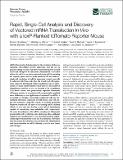| dc.contributor.author | Kauffman, Kevin John | |
| dc.contributor.author | Oberli, Matthias | |
| dc.contributor.author | Dorkin, Joseph Robert | |
| dc.contributor.author | Hurtado, Juan E. | |
| dc.contributor.author | Kaczmarek, James Cliff | |
| dc.contributor.author | Bhadani, Shivani | |
| dc.contributor.author | Wyckoff, Jeffrey | |
| dc.contributor.author | Langer, Robert S | |
| dc.contributor.author | Jaklenec, Ana | |
| dc.contributor.author | Anderson, Daniel Griffith | |
| dc.date.accessioned | 2019-08-27T15:43:53Z | |
| dc.date.available | 2019-08-27T15:43:53Z | |
| dc.date.issued | 2018-03 | |
| dc.date.submitted | 2017-09 | |
| dc.identifier.uri | https://hdl.handle.net/1721.1/122015 | |
| dc.description.abstract | mRNA therapeutics hold promise for the treatment of diseases requiring intracellular protein expression and for use in genome editing systems, but mRNA must transfect the desired tissue and cell type to be efficacious. Nanoparticle vectors that deliver the mRNA are often evaluated using mRNA encoding for reporter genes such as firefly luciferase (FLuc); however, single-cell resolution of mRNA expression cannot generally be achieved with FLuc, and, thus, the transfected cell populations cannot be determined without additional steps or experiments. To more rapidly identify which types of cells an mRNA formulation transfects in vivo, we describe a Cre recombinase (Cre)-based system that permanently expresses fluorescent tdTomato protein in transfected cells of genetically modified mice. Following in vivo application of vectored Cre mRNA, it is possible to visualize successfully transfected cells via Cre-mediated tdTomato expression in bulk tissues and with single-cell resolution. Using this system, we identify previously unknown transfected cell types of an existing mRNA delivery vehicle in vivo and also develop a new mRNA formulation capable of transfecting lung endothelial cells. Importantly, the same formulations with mRNA encoding for fluorescent protein delivered to wild-type mice did not produce sufficient signal for any visualization in vivo, demonstrating the significantly improved sensitivity of our Cre-based system. We believe that the system described here may facilitate the identification and characterization of mRNA delivery vectors to new tissues and cell types. Keywords: mRNA; nanoparticles; reporter mouse; single-cell analysis; flow cytometry | en_US |
| dc.description.sponsorship | National Cancer Institute (U.S.) (Grant P30‐CA14051) | en_US |
| dc.language.iso | en | |
| dc.publisher | Elsevier BV | en_US |
| dc.relation.isversionof | http://dx.doi.org/10.1016/J.OMTN.2017.11.005 | en_US |
| dc.rights | Creative Commons Attribution-NonCommercial-NoDerivs License | en_US |
| dc.rights.uri | http://creativecommons.org/licenses/by-nc-nd/4.0/ | en_US |
| dc.source | Elsevier | en_US |
| dc.title | Rapid, Single-Cell Analysis and Discovery of Vectored mRNA Transfection In Vivo with a loxP-Flanked tdTomato Reporter Mouse | en_US |
| dc.type | Article | en_US |
| dc.identifier.citation | Kauffman, Kevin J. et al. "Rapid, Single-Cell Analysis and Discovery of Vectored mRNA Transfection In Vivo with a loxP-Flanked tdTomato Reporter Mouse." Molecular Therapy Nucleic Acids 10 (March 2018): 55-63 © 2017 The American Society of Gene and Cell Therapy | en_US |
| dc.contributor.department | Massachusetts Institute of Technology. Department of Chemical Engineering | en_US |
| dc.contributor.department | Massachusetts Institute of Technology. Department of Biology | en_US |
| dc.contributor.department | Massachusetts Institute of Technology. Department of Biological Engineering | en_US |
| dc.contributor.department | Massachusetts Institute of Technology. Institute for Medical Engineering & Science | en_US |
| dc.contributor.department | Harvard University--MIT Division of Health Sciences and Technology | en_US |
| dc.contributor.department | Koch Institute for Integrative Cancer Research at MIT | en_US |
| dc.relation.journal | Molecular Therapy Nucleic Acids | en_US |
| dc.eprint.version | Final published version | en_US |
| dc.type.uri | http://purl.org/eprint/type/JournalArticle | en_US |
| eprint.status | http://purl.org/eprint/status/PeerReviewed | en_US |
| dc.date.updated | 2019-08-09T14:55:31Z | |
| dspace.date.submission | 2019-08-09T14:55:33Z | |
| mit.journal.volume | 10 | en_US |
